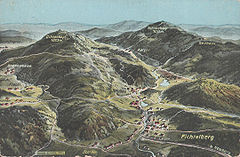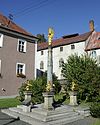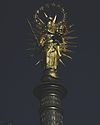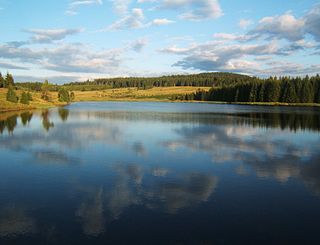
The Ore Mountains lie along the Czech–German border, separating the historical regions of Bohemia in the Czech Republic and Saxony in Germany. The highest peaks are the Klínovec in the Czech Republic at 1,244 metres (4,081 ft) above sea level and the Fichtelberg in Germany at 1,215 metres (3,986 ft).

The Fichtel Mountains is a mountain range in Germany and the Czech Republic. They extend from the valley of the Red Main River in northeastern Bavaria to the Karlovy Vary Region in western Czech Republic. The Fichtel Mountains contain an important nature park, the Fichtel Mountain Nature Park. The Elster Mountains are a part of the Fichtel Mountains.

The White Main, is the larger and shorter of the two headstreams of the river Main. It rises in the Fichtel Mountains and merges near Steinenhausen, southwest of Kulmbach, with the left-hand, southern headstream, the Red Main, to form the Main. The length of the White Main is 51.7 km. The source of the White Main lies on light granite rock, which lends it its white colouration.

A hammer mill, hammer forge or hammer works was a workshop in the pre-industrial era that was typically used to manufacture semi-finished, wrought iron products or, sometimes, finished agricultural or mining tools, or military weapons. The feature that gave its name to these workshops was the water-driven trip hammer, or set of hammers, used in the process. The shaft, or 'helve', of the hammer was pivoted in the middle and the hammer head was lifted by the action of cams set on a rotating camshaft that periodically depressed the end of the shaft. As it rose and fell, the head of the hammer described an arc. The face of the hammer was made of iron for durability.

Bad Berneck im Fichtelgebirge is a spa town in the district of Bayreuth, in Bavaria, Germany. It is situated on the White Main river, in the Fichtel Mountains, 13 km northeast of Bayreuth. It lies in the northern part of the Bavarian province of Upper Franconia. Since 1857 it has been a spa, initially based on its climate and whey products. In 1930 it became a Kneipp spa and, in 1950, a Kneipp health spa.

The Red Main is a river in southern Germany. It is the southern, left headstream of the river Main. It rises in the hills of Franconian Switzerland, near Haag and flows generally northwest through the towns Creußen, Bayreuth, Heinersreuth and Neudrossenfeld. It merges with the White Main near Kulmbach to form the Main. The Red Main is 72 kilometres (45 mi) long and descends a total of 283 metres (928 ft).
The Neusorg–Fichtelberg railway was a German branch line northern Bavaria. It linked the town of Fichtelberg in the Upper Franconian county of Bayreuth with Neusorg station in the Upper Palatine county of Tirschenreuth on the main line from Nuremberg to Cheb. This standard gauge, single-track Lokalbahn was 14.7 km long and was opened on 20 December 1890 by the Royal Bavarian State Railways.

The Fichtel Mountain Nature Park lies in the tri-border area of Saxony, the Czech Republic and Bavaria and has an area of 1,020 km2 (390 sq mi). It is maintained by the Naturpark Fichtelgebirge e. V. in Wunsiedel.
The Kohlberg is a forested mountain made of quartz phyllite in northeast Bavaria, south of Arzberg. Its summit is 632 m above sea level (NN) high and it is one of the highest mountains in the Fichtel Mountains.

The Ochsenkopf is the second-highest mountain in the Fichtel Mountains with a height of 1,024 metres (3,360 ft). On its summit is an observation tower and a transmission tower for VHF and TV programmes by Bayerischer Rundfunk.

The Fichtelnaab is a river, 47.5 kilometres long, in Upper Franconia and the Upper Palatinate, Bavaria, Germany. It rises in the Fichtel Mountains and flows into the Waldnaab near Windischeschenbach.

The Fichtelgebirge Club is a large walking club and local heritage society in Bavaria and recognised conservation group with 20,000 members in 55 local groups. As the name says, its main sphere of activity is in the Fichtel Mountains in north Bavaria. Its emblem is the Arctic starflower.

The Kösseine is a massif in the High Fichtel mountains in Germany, lying in northeast Bavaria south of Wunsiedel. The highest elevation of this granite massif is the summit of the Große Kösseine, 939 m above sea level (NN). The border between the Bavarian provinces of Upper Franconia and Upper Palatinate runs over the Kösseine as does the European watershed between the North Sea and the Black Sea. Around the Kösseine are the settlements of Wunsiedel, Marktredwitz, Bad Alexandersbad, Waldershof, Hohenhard, Neusorg, Brand, Ebnath, Nagel and Tröstau, tourist resorts within the Fichtel Mountains.

The Steinwald is a mountain range up to 946 m above sea level (NN) in southern Germany and, at the same time, a nature park founded in 1970 with an area of 246 square kilometres (95 sq mi) in the province of Upper Palatinate, in North Bavaria.
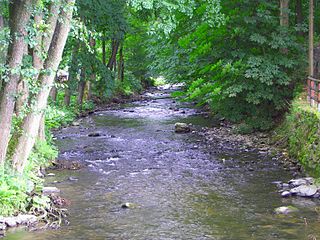
The Ölschnitz is a right-bank, northern headstream of the White Main in the German province of Upper Franconia in Bavaria. It is 22.1 kilometres (13.7 mi) long.
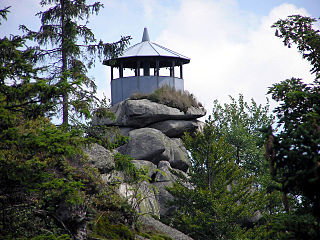
The Großer Waldstein is part of the Waldstein range in the Fichtel Mountains of Germany. It is known primarily for its rock formations caused by spheroidal weathering, its ruined castles and the only remaining bear trap (Bärenfang) in the region.
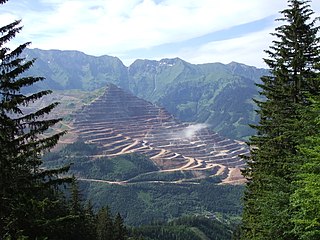
The Erzberg mine is a large open-pit mine located in Eisenerz, Styria, in the central-western part of Austria, 60 km north-west of Graz and 260 km south-west of the capital, Vienna. The deposit lies at the Northern fringes of the Eastern greywacke zone, a band of Paleozoic metamorphosed sedimentary rocks that run east-west through the Austrian Alps, rich in copper and iron ore. Erzberg is the largest iron ore reserves in Austria, having estimated reserves of 235 million tonnes of ore. The mine produces around 3.2 million tonnes of pure iron ore per year. It is also the site of the annual Erzberg Rodeo hard enduro motorbike race.

The Jean-Paul-Weg is a 150 km hiking trail in Germany in honour of the writer Jean Paul Friedrich Richter (1763–1825), leading through the Franconian Forest, Fichtel Mountains, and Little Switzerland.
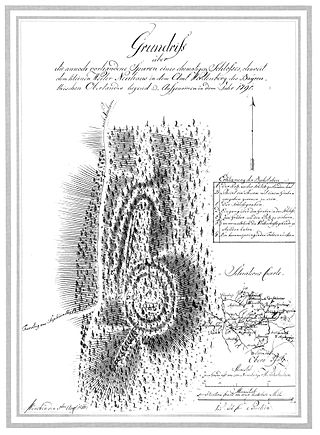
The Burgstall of Schlosshügel near Weidenberg is a lost hill castle or circular rampart site of the type known as a motte from the Early Middle Ages. It lies on the southern perimeter of the Fichtel Mountains at a height of 699 metres above sea level (NN) above the village of Sophienthal, which is part of the market borough of Weidenberg in the Upper Franconia county of Bayreuth in Bavaria. The burgstall or lost castle site was partly investigated by means of an archaeological test excavation and was also mapped several times in the past.

Adolphus William Copper Smelter is a heritage-listed former copper smelter and associated mining camp at Westwood and Oakey Creek in Rockhampton Region, Queensland, Australia. It was built in 1874. It was added to the Queensland Heritage Register on 13 May 2011.


